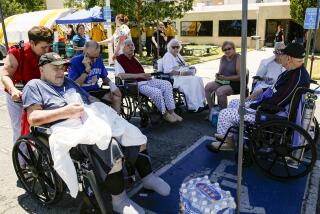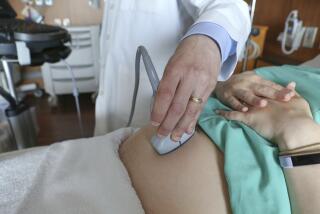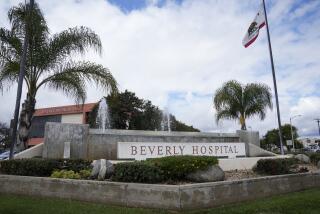Heart Bypasses: The More, the Safer : UC Study Finds Busier Hospitals Have Best Rate of Success
- Share via
Patients who have heart bypass surgery, particularly the elderly and those who undergo the procedure on an emergency basis, are more likely to survive and to avoid complications if they go to a hospital that performs more than 200 such operations a year, according to a UC San Francisco Medical Center study of state hospitals.
The report was accompanied by a list of hospitals ranked according to the number of bypass surgeries they performed in 1983, the year that was studied.
If bypass surgery were performed only at the busier hospitals, the researchers estimated, up to 300 lives, 75,000 “hospital days” and $166 million might be saved annually in the United States. The study released Wednesday was prepared for Blue Shield of California.
The report recommended that the lowest volume hospitals, instead of trying to perform more bypass operations, stop doing them altogether.
In hospitals that performed less than 100 bypass surgeries a year, 5% of patients died and 22% had “poor outcomes,” including deaths and longer stays in the hospital resulting from complications, such as infections. Among the largest and best known of the 12 hospitals in this group are Harbor-UCLA Medical Center, Hollywood Presbyterian Medical Center and County-USC Medical Center.
In hospitals that performed more than 350 operations a year, 3% of patients died and 11% had poor outcomes.
“These results are pretty startling,” said Jonathan A. Showstack, assistant professor of health policy at UC San Francisco and principal author of the study.
Death rates at hospitals that performed between 100 and 350 operations averaged 4%. In the hospitals that performed 101 to 200 surgeries a year, 16% of the patients had poor outcomes, as contrasted with 13% in hospitals that performed 201 to 350 surgeries a year.
The busier hospitals also tended to have the lowest costs, in part because their patients had fewer complications and could leave the hospital sooner, the researchers found.
The worst results were for emergency cases in the group of hospitals that did less than 100 of the surgeries a year. In such cases, 7% of patients at these hospitals died and 36% had poor outcomes.
Surgeons at these hospitals had mixed reactions to the study.
“I agree that we . . . should have centers for major surgeries, such as trauma, transplantation and heart surgery,” said Dr. M. Hadi Salem, chief of thoracic surgery at Hollywood Presbyterian.
Conclusion Disputed
Dr. Ronald J. Nelson, the chief cardiac surgeon at Harbor-UCLA, disputed the conclusion that bypass surgery should be done only at the busiest hospitals.
“One has to look very carefully at (the patients served) by individual institutions,” he said. “To simply look at the numbers is fraught with hazard.”
The best results for emergency cases were in the 17 hospitals that performed more than 350 surgeries a year. Four percent of the patients at such hospitals died, and 20% had poor outcomes. These hospitals included St. Vincent Medical Center, Cedars-Sinai Medical Center, Memorial Medical Center of Long Beach, the Kaiser Foundation Hospital on Sunset Boulevard and five others in Southern California.
“Patients should probably not have these operations at very low-volume hospitals,” Showstack said in an interview. “Many of these patients may do better if they are stabilized and transferred to a higher-volume local hospital.”
For many complicated surgeries, success is related to the experience of the surgeons and other hospital personnel. The UC study expanded on earlier studies showing that death rates from bypass surgery decrease as the the number of operations at a hospital increases. It used more complete data and examined such additional factors as emergency surgery, days in the hospital and the costs of care.
In a heart bypass operation, surgeons relieve blockages in the the coronary arteries that supply blood to the heart by replacing sections of these arteries with undamaged blood vessels from elsewhere in the body.
175,000 This Year
The procedure is one of the most common and expensive of all operations. More than 175,000 such surgeries will be performed in the United States this year, accounting for total hospital and physician charges of about $7 billion, according to the researchers.
The operation has been shown to increase survival for some patients with severe coronary artery disease and to provide more effective pain relief than medicines for some patients with angina, a chest pain caused by an inadequate blood supply to the the heart. However, some health policy experts contend that the surgery is performed more often than is necessary.
In the San Francisco study, data was analyzed on nearly 19,000 patients at 77 hospitals in the state that performed more than 20 of the procedures. Veterans Administration hospitals were not included in the study. The results were adjusted for such factors as the age and sex of patients, as well as the severity of their heart disease.
Total hospital charges for an average surgery in 1983 dollars was $25,400, and the patients spent an average of 13 days in the hospital.
In the study, deaths and complication rates were reported only for groups of hospitals that had similar numbers of operations but not for individual hospitals. The low-volume hospitals each had too few surgeries to permit meaningful comparisons between institutions.
Decision Defended
The decision not to list death rates for individual hospitals was defended by Dr. Ralph Schaffarzick, Blue Shield senior vice president and medical director.
The goal was to point out the many “well-qualified” hospitals throughout the state, not “to identify the bad hospitals,” Schaffarzick said. “Most of the low-volume hospitals are within 40 miles of a center doing more than 200 operations.”
In March, the federal Health Care Financing Administration released death rates for Medicare patients at hospitals throughout the country, including deaths from bypass surgery and eight other common conditions.
Schaffarzick said many Blue Shield “preferred hospitals” in the state performed more than 200 bypass surgeries a year.
“We are already encouraging (our subscribers) to use them,” he said.
HEART BYPASS SURGERY
BYPASS OPERATIONS AT SOUTHERN CALIFORNIA HOSPITALS Patients have a significantly better chance of surviving coronary artery bypass graft surgery and making a good recovery if they are treated at a hospital where more than 200 of the operations are performed each year, according to a new study by researchers at the UC Medical Center, San Francisco. These are the Southern California hospitals which performed 20 or more heart bypass surgeries during the study year of 1983 and the number of operations at each.
20 TO 100 OPERATIONS A YEAR
UC Irvine Medical Center Orange 20
Good Samaritan Hospital Anaheim 34
LA County-Harbor UCLA Torrance 46
Hollywood Presby. Los Angeles 62
LA County-USC Los Angeles 68
Beverly Hospital Montebello 89
Long Beach Comm. Long Beach 94
Los Robles Regional Thousand Oaks 98
St. John’s Regional Oxnard 99
101 TO 200 OPERATIONS
White Memorial Los Angeles 101
Granada Hills Granada Hills 104
Community Mem. Hosp. Ventura 107
Santa Monica Hospital Santa Monica 108
St. John’s Hospital Santa Monica 115
Garfield Medical Center Monterey Park 118
Goleta Valley Comm. Santa Barbara 118
St. Mary Med. Center Long Beach 122
St. Francis Med. Center Lynwood 133
Hoag Mem. Presby. Newpt. Beach 135
Lancaster Comm. Hospital Lancaster 138
Glendale Adventist Glendale 146
Fountain Valley Fountain Valley 149
Western Medical Center Santa Ana 159
Northridge Hospital Northridge 166
St. Joseph Burbank 168
Valley Presbyterian Van Nuys 175
Brotman Medical Center Culver City 188
Presbyterian Intercommunity Whittier 189
201 TO 350 OPERATIONS UCLA Medical Center Los Angeles 202
Torrance Memorial Hospital Torrance 220
UC San Diego San Diego 226
St. Bernardine Hospital San Bernardino 244
Eisenhower Med. Center R. Mirage 256
St. Joseph Hospital Orange 264
S. Barbara Cottage Hosp. S. Barbara 285
Little Company of Mary Torrance 286
Daniel Freeman Hospital Inglewood 287
Huntington Mem. Hospital Pasadena 295
Hospital of Good Sam. Los Angeles 306
Mercy Hospital San Diego 310
San Joaquin Hospital Bakersfield 316
Encino Hospital Encino 323
St. Jude Hospital Fullerton 334
351 OR MORE OPERATIONS Kaiser Foundation Hosp. Los Angeles 355
Memorial Medical Center Long Beach 363
Scripps Memorial Hospital La Jolla 374
Anaheim Memorial Hospital Anaheim 379
Loma Linda Med. Center Loma Linda 385
Alvarado Hospital San Diego 386
Cedars-Sinai Los Angeles 572
Sharp Memorial Hospital San Diego 852
St. Vincent Med. Center Los Angeles 1016
Source: California Health Facilities Commission






